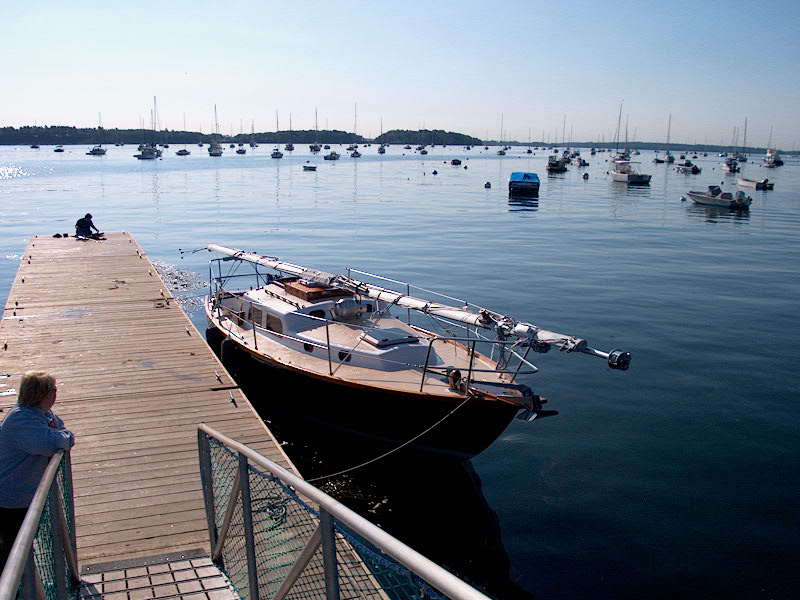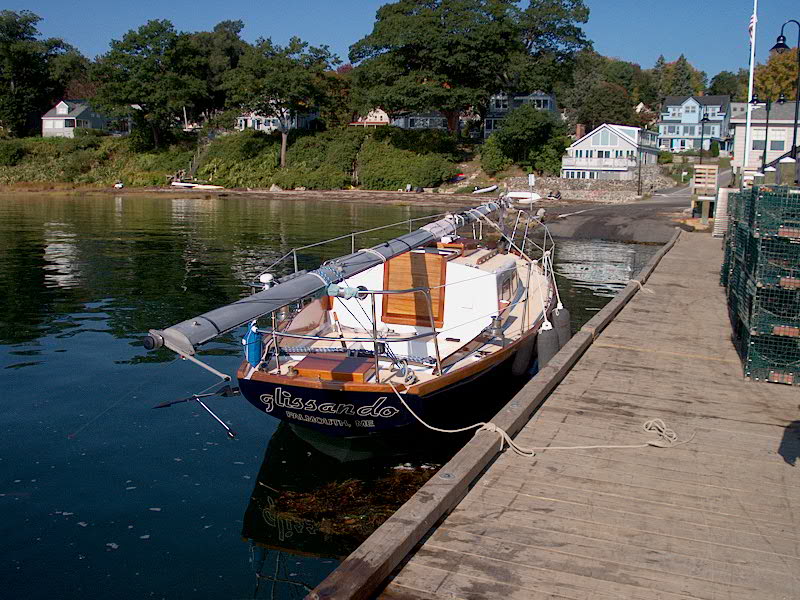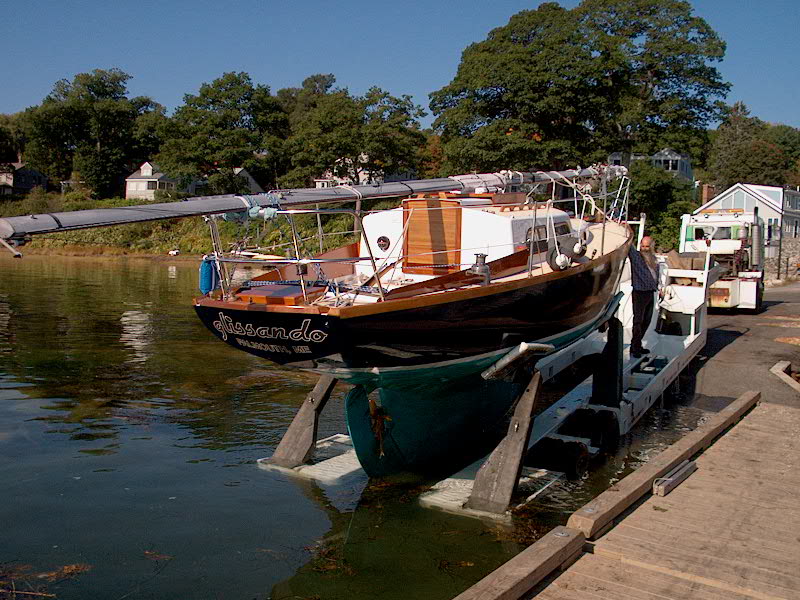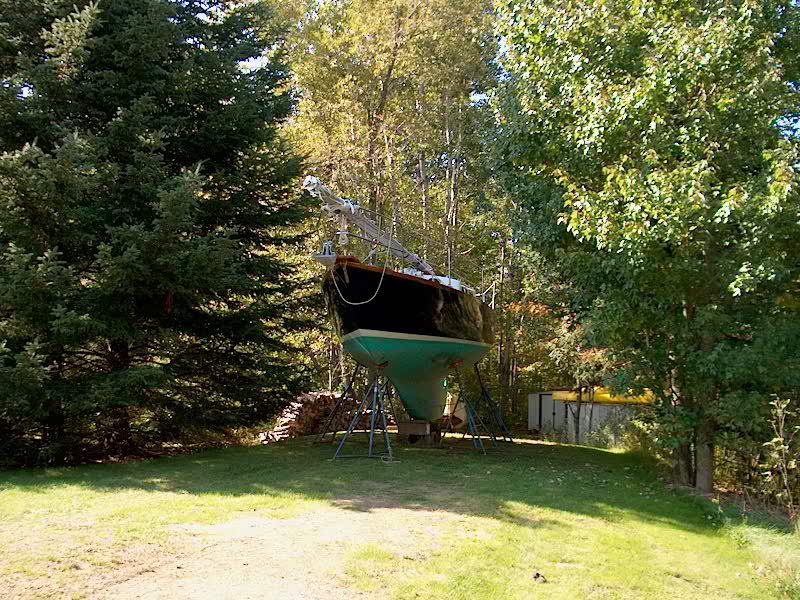|
Haulout for the Winter: 2001
October 2, 2001
It may seem early to some of you, but we're
actually hauling out after a lot of people around here (and before many others,
though). However, while there are undoubtedly some excellent and beautiful
sailing days possible through October, things really wind down--and there can be
really lousy, raw weather a lot of the time too. Our yacht club shuts down
by mid-October, and once the launch ends and the floats get pulled out, getting
to the boat becomes difficult enough as to make going out kind of a pain.
Also, in our unprotected mooring anchorage, fall storms that can come nearly
without warning can take a heavy toll on unprepared boats. For a few
possible nice days, is it worth the risk? Not for me. For those of
you used to mooring in a marina in a calm, protected cove, the possibility of
damage from a storm may seem distant. However, in the northeast, moorings
are the rule, and most of the harbors, while protected from the ocean and the
worst of any storm, still can be very nasty in the wind directions usually
encountered in fall storms--either southerly or northeasterly. If not for
this very real risk, I'd probably want to stay in for a few more weeks. We
also like to travel in October, and I'd be a nervous wreck trying to leave the
boat in the water while we were away. Sooo...we haul out in early
October. We do go in earlier than most, though, in late April or early
May. Need a very graphic illustration of what can happen--and what I have
seen happen locally in the past? Click
here for the sad saga of the Triton Carina, a victim of the October
1990 storm that became famous as "The Perfect Storm".
To prepare for haulout,
we first had to remove
the sails, dodger, etc. to get ready to pull the mast. But first, we had one
beautiful final sail, then came into the dock and folded the sails and removed
some other gear, including the boom. The next day, I motored into Handy's
to get the mast unstepped, which went well and only took 45 minutes or an hour,
all told. I had them lay the mast down on top of the pulpits, as I wanted
to bring it home. Storage for the mast in the yard may be an option in
future years, but there are a few things I want to take care of on the mast this
season. Once it was down, I spent some time removing the jumpers and
spreaders and tying up all the rigging, and securing the mast very well to the
boat.
With the high doghouse aft, the mast just
clears the top of the sea hood when it's laid across. It's kind of a pain, as the mast is low enough that I can't get the
drop boards into the companionway without lifting the mast. I had to
shoulder under the mast to get the three boards in, and shut the companionway
slide, before securing the aft end of the mast for good. When I get the
boat home, I'll build some wooden supports for the mast that will raise it up
high enough so that I can more easily get in and out; I didn't like the ones I
built last spring, and trashed them--too wobbly. When I go out to motor
the boat into the ramp for hauling, I won't even have to go below, so I'll just
leave the hatch closed. Then I can work on a better mast solution later,
in the luxury and convenience of my backyard. Click
here to see the supports I built.
I like to make allowances for the possibility
of bad weather, so I had scheduled the unstepping to occur late one week, and
the launching early the next week--with a day or two in there in case I couldn't
get the mast out as scheduled. All went well, so of course this left us
without the use of our boat for a 4-day period. Fortunately (I guess), it
blew very hard all weekend, so we probably wouldn't have gone sailing
anyway. The weather was perfect September, though. It's kind of
amazing how much time gets freed up when going boating isn't even an option!
|
|
 Sadly, our trusted boat hauler, Richardson's,
decided that they needed to concentrate on their core business--they have a
large marina/boatyard/sales office on Sebago Lake. Earlier in the summer,
I received a letter from them with the news that they would be ceasing in the
business of boat hauling in September. This left me, and many other
loyal customers, to scramble to make other arrangements for the fall
haulout. I contracted Dayton Marine to haul the boat--the other
"big" name in boat hauling around here. There's a third hauler
who I won't even mention by name here...but I'll bet anyone local will know who
it is. If not, then consider yourself lucky. Sadly, our trusted boat hauler, Richardson's,
decided that they needed to concentrate on their core business--they have a
large marina/boatyard/sales office on Sebago Lake. Earlier in the summer,
I received a letter from them with the news that they would be ceasing in the
business of boat hauling in September. This left me, and many other
loyal customers, to scramble to make other arrangements for the fall
haulout. I contracted Dayton Marine to haul the boat--the other
"big" name in boat hauling around here. There's a third hauler
who I won't even mention by name here...but I'll bet anyone local will know who
it is. If not, then consider yourself lucky.
|
|
 The
appointed day arrived--we were scheduled for 10:15 in the morning on the
2nd--and, true to form, I allowed way too much time to get to the boat and motor
it in from the mooring to Falmouth Town Landing, so we had to kill about an hour
waiting. No problem, though--it was a gorgeous fall day, with abnormally
high temperatures, crisp blue sky, and light winds. Beautiful! I
docked on the outer floats when I arrived because there were a couple lobster
boats on the ramp floats. When they left after about half an hour, I moved
Glissando in to those floats so that we could easily pull the boat onto
the trailer with the docklines. The
appointed day arrived--we were scheduled for 10:15 in the morning on the
2nd--and, true to form, I allowed way too much time to get to the boat and motor
it in from the mooring to Falmouth Town Landing, so we had to kill about an hour
waiting. No problem, though--it was a gorgeous fall day, with abnormally
high temperatures, crisp blue sky, and light winds. Beautiful! I
docked on the outer floats when I arrived because there were a couple lobster
boats on the ramp floats. When they left after about half an hour, I moved
Glissando in to those floats so that we could easily pull the boat onto
the trailer with the docklines.
|
|
 At
10:00 on the dot, Bucky (the driver/owner of Dayton Marine) arrived.
Early--I like that. We had to move a poor scared woman holding vigil in
her husband's duck/fishing boat that they had just launched. he had gone
to part the truck and trailer, and she was left to hang onto the dock. We
carefully pulled the boat around Glissando--I nearly dropped the
shoelace-sized dockline (the only line on the boat, apparently). The poor
lady thought she was a goner...but I grabbed the line before it fell overboard
and successfully completed the transfer. Then, we pulled Glissando
onto the now-submerged hydraulic trailer, Bucky positioned the pads, and the
trailer with its precious cargo (to me, anyway) was pulled out of the
water. The season was officially over. At
10:00 on the dot, Bucky (the driver/owner of Dayton Marine) arrived.
Early--I like that. We had to move a poor scared woman holding vigil in
her husband's duck/fishing boat that they had just launched. he had gone
to part the truck and trailer, and she was left to hang onto the dock. We
carefully pulled the boat around Glissando--I nearly dropped the
shoelace-sized dockline (the only line on the boat, apparently). The poor
lady thought she was a goner...but I grabbed the line before it fell overboard
and successfully completed the transfer. Then, we pulled Glissando
onto the now-submerged hydraulic trailer, Bucky positioned the pads, and the
trailer with its precious cargo (to me, anyway) was pulled out of the
water. The season was officially over.
|
|
 We
drove home and awaited Bucky's arrival. Before long, the boat was placed
back where she had sat for so long and, when the truck was gone, it was eerily reminiscent
of the two years during which she sat in nearly the exact same spot while I
worked feverishly to restore and rebuild her. Only this time, there was no
plastic shed around her. Let the withdrawal symptoms begin! We
drove home and awaited Bucky's arrival. Before long, the boat was placed
back where she had sat for so long and, when the truck was gone, it was eerily reminiscent
of the two years during which she sat in nearly the exact same spot while I
worked feverishly to restore and rebuild her. Only this time, there was no
plastic shed around her. Let the withdrawal symptoms begin!
 The
boat looked great as I inspected things. The hull was a little salt
stained, and the waterline aft was covered with junk that had been in the water
at the town landing during haulout. A quick washdown took The
boat looked great as I inspected things. The hull was a little salt
stained, and the waterline aft was covered with junk that had been in the water
at the town landing during haulout. A quick washdown took  care
of this, and the hull once again sparkled. The bottom was extremely
clean--only a small amount of slime here and there, and a little growth on the
rudderpost and propeller shaft. There was some water dripping out of the
bottom of the false keel, signaling that my last minute patch job had indeed let
some water in, as I had thought. I had Bucky block the boat so that the
blocking was entirely beneath the ballast keel, leaving the after portion
completely open so that I can effect proper repairs before next season. care
of this, and the hull once again sparkled. The bottom was extremely
clean--only a small amount of slime here and there, and a little growth on the
rudderpost and propeller shaft. There was some water dripping out of the
bottom of the false keel, signaling that my last minute patch job had indeed let
some water in, as I had thought. I had Bucky block the boat so that the
blocking was entirely beneath the ballast keel, leaving the after portion
completely open so that I can effect proper repairs before next season.
To keep junk from the birch trees just behind
the boat from landing on the boat, I spread a small tarp over the mast and tied
it to the lifelines--just enough to keep tree droppings, which seem to stain everything
badly, from landing on the boat. In the coming few weeks, I'll fashion a
real framework for the winter cover, and cover the boat--by the end of the
month. Stay tuned.
|
|